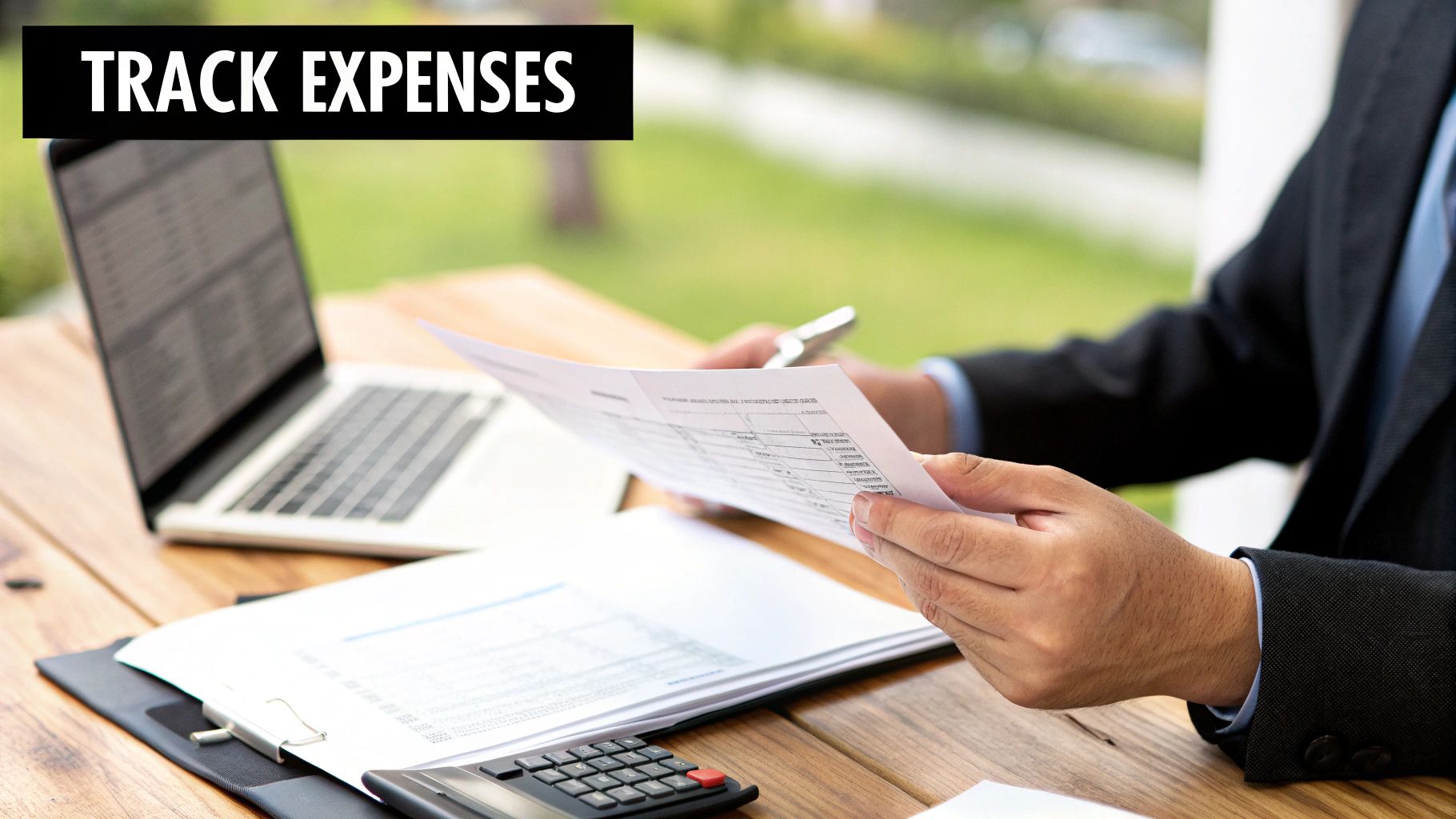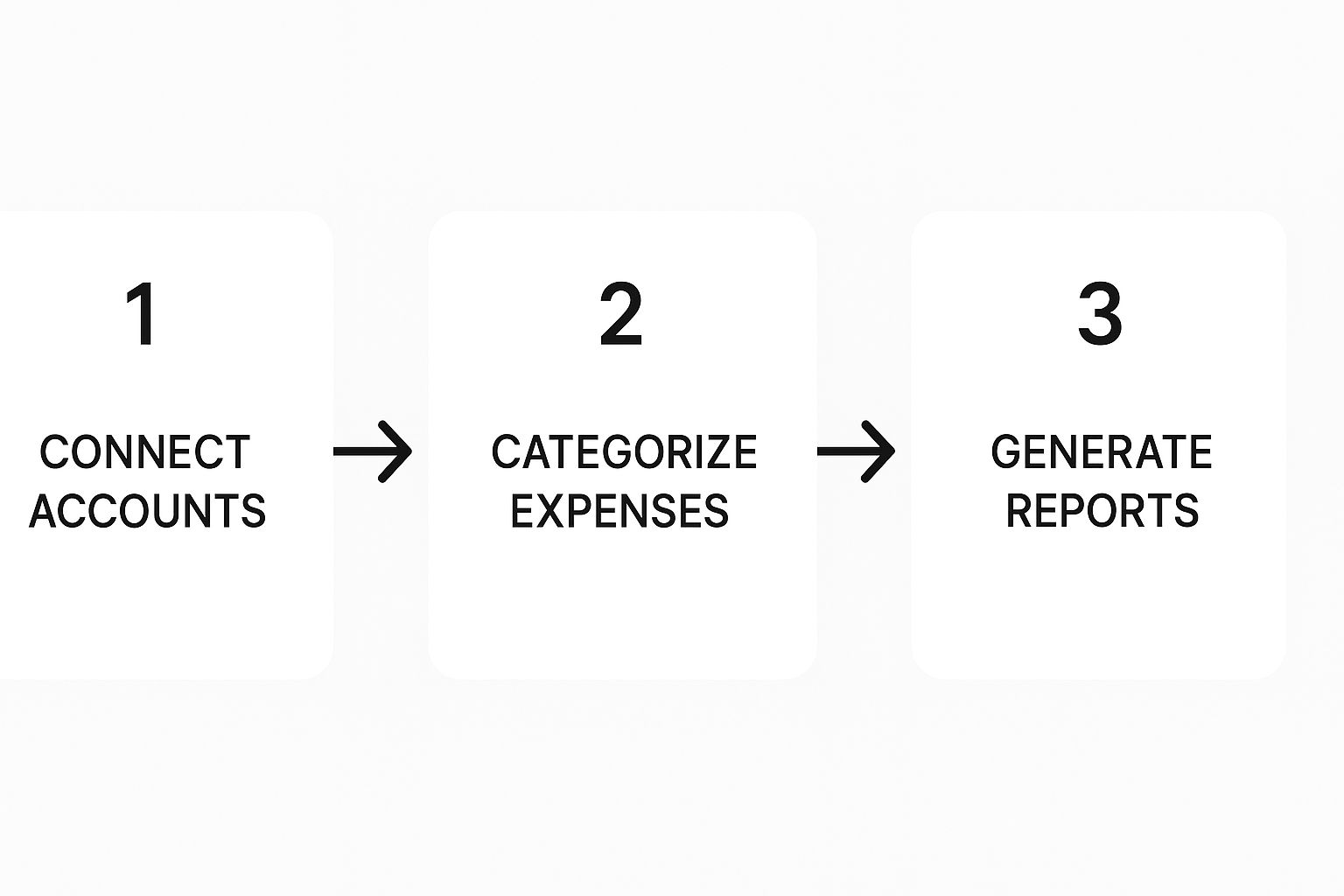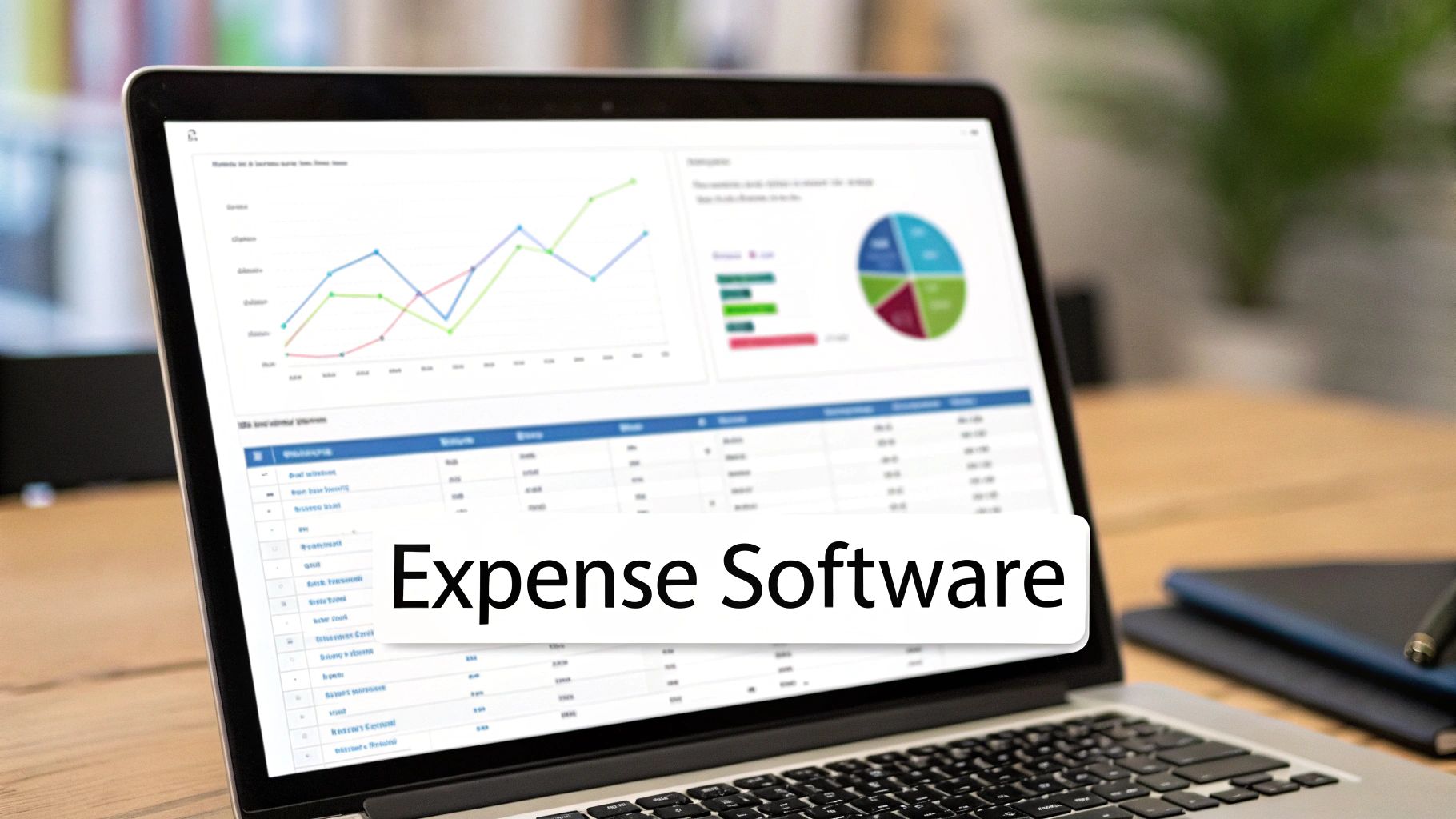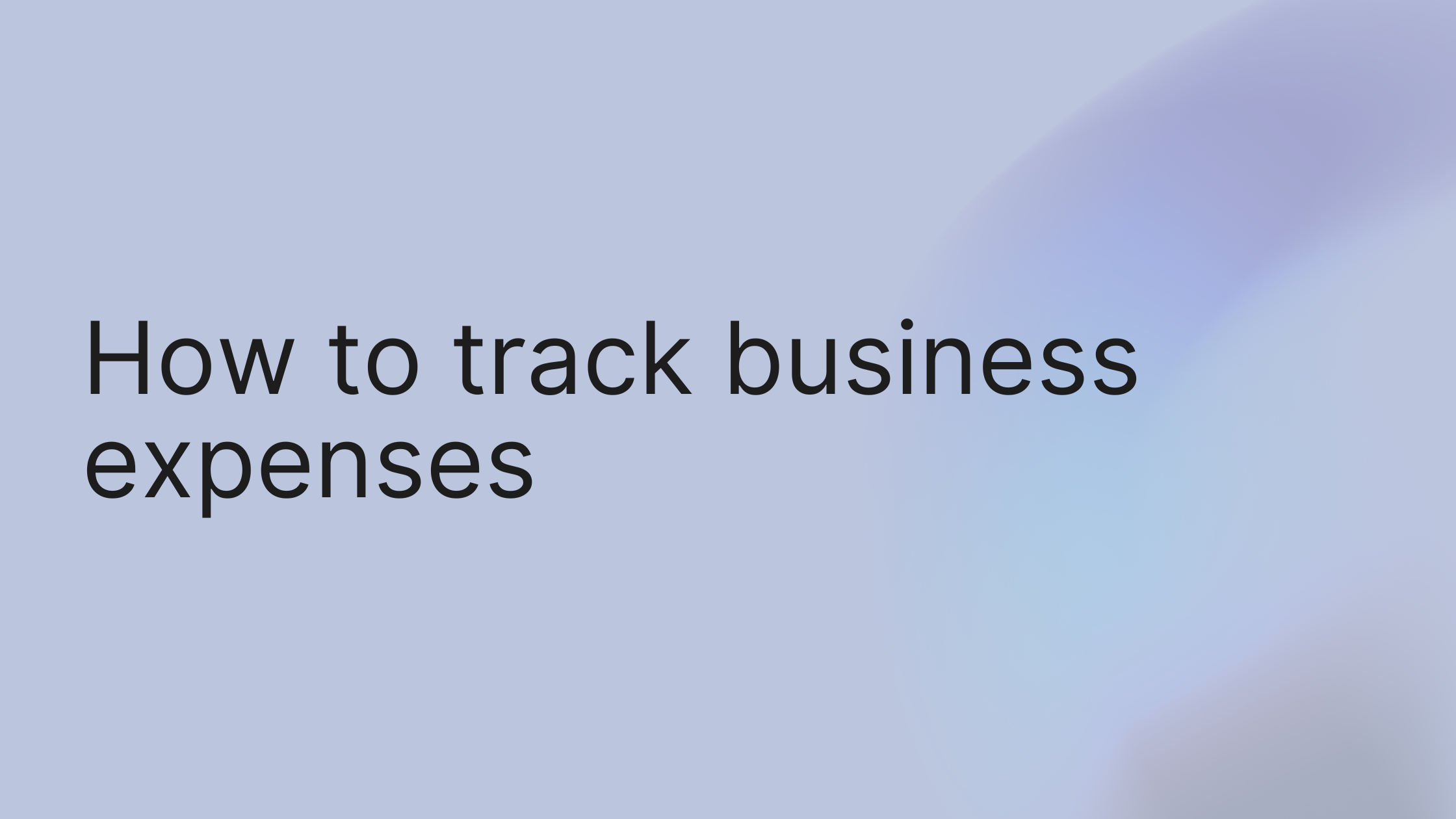Staring at a shoebox full of crumpled receipts and a messy spreadsheet? It’s a classic small business pain point. The single most effective way to start tracking your business expenses is to choose one dedicated system and stick with it. Stop juggling multiple methods. This one change brings immediate clarity and lays the groundwork for getting a real handle on your finances.
Starting Your Expense Tracking Journey
That feeling of being overwhelmed by financial chaos is something almost every business owner has felt. The good news? Building a solid system to track business expenses is less about being an accounting whiz and more about developing consistent habits. Your first and most powerful move is to step away from manual methods that are magnets for errors and black holes for your time.
Let's bring some immediate order to the madness. Here is your actionable, step-by-step plan:
Open One Dedicated Business Bank Account: Stop co-mingling personal and business funds. This is non-negotiable and the foundation for clean books.
Choose Your Tracking Method: Decide between a simple spreadsheet (for very low transaction volume) or dedicated software like growlio.
Capture Every Expense Immediately: Get into the daily habit of snapping a photo of every receipt the moment you get it. Your phone is your new shoebox.
Categorize As You Go: Don't wait until month-end. Assign each expense to a category when you capture it.
Schedule a Weekly Review: Block 15-30 minutes on your calendar each week to review spending, ensuring everything is categorized correctly.
From Manual Mess to Automated Success
Let's look at a real-world example. A local design agency, "Pixel Perfect," used to burn over 10 hours every month manually keying in receipts from a shared folder into a massive spreadsheet. They were constantly missing small purchases and dreaded month-end reconciliation.
After switching to an automated system like growlio, they slashed that reconciliation time to just one hour a month. Even better, by analyzing their new, clean reports, they discovered they were overspending by nearly 15% on redundant software subscriptions—an insight their old spreadsheet could never have provided.

Expense Tracking Methods at a Glance
Upgrading from a manual system to an automated one can feel like a big leap, but the benefits become clear very quickly. Here’s a straightforward comparison to show you what you stand to gain.
Feature | Manual Tracking (Spreadsheets/Paper) | Automated Software (like growlio) |
|---|---|---|
Data Entry | Time-consuming and prone to human error. | Automatic receipt scanning and data extraction. |
Real-Time View | No real-time data; always looking backward. | Instant, up-to-the-minute view of spending. |
Categorization | Manual sorting; often inconsistent. | Smart, AI-powered categorization with custom rules. |
Reporting | Requires building formulas and pivot tables. | One-click, customizable reports for insights. |
Integration | Disconnected from banks and credit cards. | Direct sync with bank accounts and credit cards. |
Accessibility | Limited to a specific device or physical location. | Accessible anywhere via cloud-based apps. |
As you can see, the difference isn't just about saving time—it's about gaining real, actionable intelligence about your business's financial health.
Choosing the Right Tools for Your Business
If your current expense "system" is a shoebox full of receipts, a clunky spreadsheet, and a separate invoicing app, you're wasting time patching together tools that don't speak the same language. The single biggest improvement you can make is to find one platform that does it all. Picking the right software is the foundation of your entire expense tracking process.
From Basic Scanners to All-in-One Platforms
Those free receipt scanning apps are handy for capturing an image on the go, but that's usually where their usefulness ends. You're still stuck manually keying that information into your books. At the other extreme, full-featured accounting software can feel like bringing a cannon to a knife fight—it's often too complex and costly for most service-based businesses.
The sweet spot for most is an all-in-one platform that integrates expense tracking directly with project management and invoicing. This gives you a complete financial picture that’s actually tied to your work. More and more businesses are seeing the light and moving away from manual data entry. Exploring different cloud accounting solutions can open your eyes to just how much of this process can be automated.
Must-Have Features for Scalability
As your business picks up steam, your tools need to keep pace. Don't settle for a system that can't grow with you. Here are the features I consider non-negotiable:
Automated Receipt Capture: The software should use Optical Character Recognition (OCR) to read the vendor, date, and amount right off a photo of a receipt. This eliminates tedious manual entry.
Bank Account Integration: The ability to securely link your business bank and credit card accounts is a game-changer. It automatically imports every transaction, so nothing falls through the cracks. In growlio, you can connect your bank account under
Settings > Integrations.Smart Categorization: A good tool will learn your spending habits and suggest expense categories, making your bookkeeping more consistent and accurate over time.
Robust Reporting: You need the ability to generate a Profit & Loss statement, expense summaries, or other key reports with just a few clicks.
Of all these features, real-time bank syncing has the biggest impact. When your software automatically pulls in every single transaction, you get a consistently up-to-date view of your business's financial health.
Building Your Daily Expense Tracking Workflow
Let's be honest: does the end of the month trigger a frantic search for crumpled receipts and a long, painful session with a spreadsheet? If so, you're not just wasting hours—you're probably leaving money on the table through missed deductions. The fix is simpler than you think. It's about building a small, repeatable daily habit that turns expense tracking from a dreaded chore into a quick, almost automatic task.
This actionable workflow is the backbone of modern expense tracking:
Capture: The moment you make a purchase, open your expense tracking app and snap a photo of the receipt. Don't wait.
Categorize: The app's OCR will pull the key data. Your only job is to confirm the expense category is correct.
Reconcile: Once a week, spend 15 minutes reviewing your synced bank transactions against your captured receipts. This ensures nothing was missed.
This infographic breaks down the simple, three-part process.
As you can see, a great workflow isn't complicated. It’s all about connecting your accounts to let automation do the heavy lifting, applying consistent categories, and then using that clean data to get real insights from reports.
From Capture to Category
Once you’ve snapped that receipt, the next crucial step is categorizing it. Getting this right is everything. Any good software will let you assign each expense to a standard bucket like:
Office Supplies
Travel & Meals
Software Subscriptions
Marketing & Advertising
Don't stop there. Get specific by creating custom categories that truly reflect how your business operates. A design agency might need "Stock Photography" or "Client-Specific Printing," while a consultant might want to track "Professional Development Courses." In growlio, you can create these under Settings > Expense Categories. This level of detail is what separates a basic expense log from a powerful business intelligence tool.
Don't Forget Cash (And Finalizing Your Records)
Even in our mostly digital world, cash expenses still pop up. The workflow here is exactly the same: get a receipt, snap a photo immediately, and assign it to a category. You have to treat cash with the same diligence as a credit card transaction. By attaching a digital receipt image to every single transaction—card or cash—you create an unshakeable audit trail. For those looking to take efficiency to the next level, it's worth exploring methods like automating financial workflows, which can dramatically improve both speed and accuracy.
Mastering Expense Categorization and Compliance

Ever find yourself staring at a receipt, completely unsure if it’s an operating cost or part of your cost of goods sold? That moment of hesitation often leads to tax headaches and a skewed view of your finances. The single biggest win here is to establish a clear, consistent categorization scheme and stick to it.
Getting your expense categories wrong is one of the fastest ways to get a misleading picture of your company's financial health. The first step toward that clarity is understanding the two main buckets your expenses fall into.
COGS vs. Operating Expenses
Think of Cost of Goods Sold (COGS) as any expense directly tied to producing your product or delivering your service. If you're a web developer, the cost of a premium plugin you buy for a specific client site is COGS. For a local bakery, it's the flour and sugar that go into the cakes.
Operating Expenses (OpEx), on the other hand, are the costs to simply keep the lights on, regardless of specific projects. This bucket includes your office rent, utility bills, and marketing campaigns. Separating these two gives you a true sense of your gross profit margin—the real money you make on what you sell.
A common pitfall is accidentally classifying personal expenses as business costs, which is a major red flag for auditors. It's really no surprise that 71% of finance leaders admit they struggle with compliance when using manual methods. You can learn more about these business expense trends and see how automation is closing these gaps.
Pro Tip: Advanced Tracking with Sub-Categories and Tags
Once you have the basics down, get deeper insights. Go beyond standard categories by creating sub-categories to monitor profitability with more precision. For example, instead of a single "Marketing" category, break it down into:
Marketing > Google Ads
Marketing > Social Media Campaigns
Marketing > Content CreationYou can also use tags to track spending across different categories for a specific project. A simple tag like
#ProjectPhoenixcan be applied to software costs, contractor payments, and even travel expenses. This gives you a complete, instant view of that project's total cost.
Taking control of your categorization isn't just about good bookkeeping—it's about unlocking the strategic story your spending data is trying to tell you.
Generating Reports for Actionable Business Insights
Does the thought of running financial reports make your eyes glaze over? So many business owners get bogged down in the day-to-day tracking but never take that final, crucial step: actually looking at the data. Let's fix that, because reports aren't just for your accountant—they're your strategic roadmap.
This is where all that diligent expense tracking pays off. With just a few clicks in modern software, you can pull up a Profit & Loss (P&L) statement or see a detailed breakdown of your expenses. Think of these reports as your business's health dashboard.
Turning Data Into Decisions
One of the most eye-opening reports you can run is a simple breakdown of spending by category. It’s the clearest way to see where every dollar goes. Here’s a perfect example of an expense-by-category report.

Right away, you can see that 'Software Subscriptions' is a huge chunk of the pie. That’s your cue to dig deeper. Are there redundant tools? Underused licenses you can cut? Another sneaky cost that often hides in plain sight is payment processing fees. Our Stripe fee calculator is a great tool for getting a handle on those specific costs.
Mini-Case Study: The Overlooked Subscription Drain
I once worked with a small marketing agency that felt like their profits were constantly being squeezed, but they couldn't pinpoint why. After we ran their first-ever expense-by-vendor report in their new software, the culprit jumped right off the page.
It turned out they were paying for three different project management tools and two separate social media schedulers. That one report showed they were bleeding over $400 a month on redundant software. By consolidating into a single platform for each function, they gave their bottom line an instant, meaningful boost. This exact scenario is playing out everywhere, especially as inflation makes old-school fixed allowances less effective.
Putting It All Together: Your Path to Financial Clarity
It's easy to look at a mountain of receipts and feel overwhelmed. But the real victory isn't in tackling the whole pile at once—it's just in deciding to start. You now have a solid framework for building a real, working system to manage your business expenses, from picking the right tools all the way to making sense of the data. The most critical step? The one you take right now.
Every lost receipt is a small leak in your financial boat. By putting these ideas into practice, you're not just plugging leaks; you're charting a course from financial guesswork to genuine control. Ready to stop guessing and start knowing? create your free growlio account to put these principles into practice today.
Answering Your Top Expense Tracking Questions
Even with the best system in place, some practical questions always pop up. Let’s tackle some of the most common questions I hear from business owners.
How Often Should I Be Tracking My Expenses?
Honestly? You should be tracking them daily. The most successful habit is capturing a receipt and logging the expense right on the spot with a mobile app. It takes just a few seconds. If you let things pile up until the end of the week or month, you're just asking for trouble. A quick, five-minute daily check-in is all it takes to keep your books clean and your stress levels low.
What's the Best Way to Keep Business and Personal Expenses Separate?
This one is crucial: get a dedicated business bank account and credit card. This is the single most important step for clean bookkeeping, and I consider it non-negotiable. Use these accounts for every single business transaction. No exceptions. This creates an automatic, crystal-clear paper trail.
Do I Really Need to Keep All These Paper Receipts?
Good news! For tax purposes in most places, a clear digital copy of a receipt is just as good as the original paper one. A good expense tracking app lets you snap a photo and securely store the image, which is exactly what you need. Once you have a secure digital copy, you can typically toss the physical one. It's a game-changer for simplifying your record-keeping.
Getting this process right is fundamental to your company's financial health. To learn more, take a look at our guide on how to improve your small business cash flow.
Ready to stop worrying about the details and start tracking like a pro? The first step is the most important one. Start your free growlio account today and finally take full control of your business finances.
